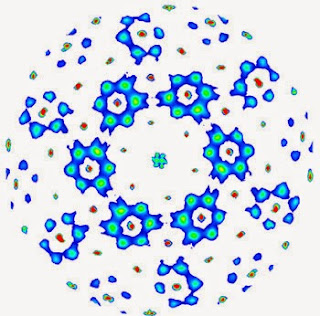 |
| Data taken with synchrotron diffraction indicates a short range, honeycomb-based nanostructure, which is the basis for the anomalous magnetism of Ba3CuSb2O9. NCNR neutron scattering data confirmed this structure and provided evidence for the resulting quantum spin liquid. Credit: H. Sawa/Nagoya University View hi-resolution image |
Topics: Ferromagnetic, Fluid Mechanics, NIST, Quantum Mechanics, Spin, Superconductivity, Superfluidity
Back from a "blog break." I saw this article last month, but delayed it until the first due to a series of work-related classes (tiring, but very good I might add). I anticipate a few more, as I have that and two family reunions this summer. Not complaining about my people, but as far as my families, they could stagger these...just saying.
Trivia: Today is my wife's birthday; yesterday we went to Shadows Restaurant - her favorite. It's also (to be seen) the expiration of the Patriot Act. CNN and 24-hour cable news was born on this day in 1980. Since I can recall the era of three major network channels, a few UHF stations and television going off at midnight, I don't know if that's a good thing or not. Due to the massive amounts of competition with channels that produce movies on demand, music and reality shows, cable news has trended towards yellow journalism. Happy 35th birthday CNN, for better or worse...
Gaithersburg, Md.—An international team of researchers including scientists from the National Institute of Standards and Technology (NIST) has found what may be the first known example of a "spin-orbital liquid," a substance in a never-before-seen quantum mechanical state.
The discovery, reported May 4, 2012, in the journal Science, has been sought for years by the physics community. Though the team does not posit immediate applications for the material, its properties relate to the same quantum effects that give rise to superconductivity, in which electricity flows through a material with no resistance, and superfluidity, in which a liquid flows across a surface with no friction.
The term "spin liquid" can be deceptive, as it describes a substance that in many ways fits our conventional understanding of a solid. Indeed, the material the team studied looks like a chunk of earth, but at the molecular level, it is made of copper, oxygen, barium and antimony atoms arranged in a crystalline lattice structure. In this particular structure the copper atoms exhibit unusual properties generally associated with liquids. Specifically, their magnetic orientation remains in a constant state of flux.
When materials with magnetic atoms—like iron—solidify, they generally do so in crystal structures whose atoms have an orderly arrangement of magnetic orientations. (When magnetic atoms interact "ferromagnetically" you get a refrigerator magnet.) Because magnetism stems from a quantum property in the atom's electrons called spin, another way of saying this is that the spins in these atoms' electrons all line up in a single direction. Ferromagnets feature an orderly, static arrangement of electron spins.
NIST Contributes to Discovery of Novel Quantum Spin-Liquid, Chad Boutin
Comments